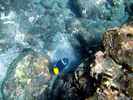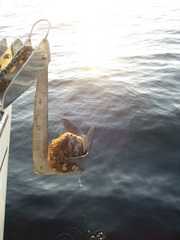Isla Isabela - Hiking, Birds Galore, and SnorkelingBy the time we got settled into our anchorage, it was already 10:00 am on Friday. Jacques Cousteau had visited this island and done a documentary about it. So, we were in good company from the start! The first thing you notice about Isla Isabela are the birds. Impossible to catch in a still photo, there were so many of them, they looked like clouds. There were literally thousands of Frigate Birds, Boobys, Pelicans, and Seagulls filling the air all above and around the island. All day long they would circle and catch the thermals and ridge lift as the wind came in and rose over the island. They would rise as much as two thousand feet over the island, presumably to get high enough to make the crossing to the mainland. It was like some kind of a dream. So, although we took a ton of still pictures, this was when I decided that there would be a movie about the trip, as I felt the still camera couldn't capture the experience well enough. So, at first I started filming with my old cheap dv camcorder, and later in the day decided to break out the new hi-def video camera and christen it with some clips of the birds and this beautiful island. You'll have to see the movie when it comes out :-) In the meantime, I was still suffering from a dozen or so bug-bites on my feet, ankles, back, and arms, along with a small cut on my leg that I was letting heal, so I/we decided to just take it easy on the boat the rest of the day. I worked on the Mazatlan web-page, as it is often the case that the first thing I do in a new port is work on the web-page for the previous one. In fact, I am writing this in Mantenchen bay, our next stop after Isabela, but that's another story. We let Friday slip by and had some nice drinks and a dinner, occasionally chatting with some of the other boats in the cove as they drove by on their dinghies. PARADISE BOUND, with Will and Elona, whom been our dockmates at Sunroad Marina in San Diego was there. They were continuing their trip, also to the Panama Canal, so we'll probably hear more from them in the future. Also anchored in the south cove when we arrived was WAHOO, the only motor boat that participated in the Baja-Ha-Ha ( by themselves in the "no-comprende" division :-). We had met them at El Cid marina in Mazatlan as they were having some refrigeration problems waiting for a new compressor to arrive from the states. They had gotten it fixed and proceeded south to Isabela ahead of us. I had a pretty miserable night as the itching from the bug bites seemed to peak during the wee-hours. The only thing that seemed to help was taking Benedryl. Nonetheless, the next morning, on Saturday, we decided to do the dinghy drill and go into shore for a hike. I got as prepared as I could by covering completely up - donning a long sleeve shirt, pants, socks, shoes, and a hat, along with a healthy dose of DEET to all exposed skin. Once we got to shore, all the effort was worthwhile. Not only were there thousands of birds in the air, but it seemed like every tree, rock, and potential perch had birds in them. We pulled the dinghy up onto the beach at the fishing camp and made a short walk out to the point where we saw dozens and dozens of nesting boobies with hatchlings. In fact there were so many that it was impossible to walk up the ridge to the point without disturbing them, so we doubled back to the fish camp. At the camp we ran into several other hikers from other boats and talked with them about where they had been and where we might go. They suggested we take the trail out the back of the camp across the island to the west side where the views were nice, so we did. Boy were they ever right! After a short 400 yard hike, we came upon the west side of the island where a tidal flat below a picturesque cliff was being washed by good sized 8-12 ft breakers. There were all kinds of crabs and other sea-life doing their chores in the tide pools. We hiked around the end of a point and then were halted when the potential path became too treacherous to continue. So once again we doubled back. We made our way to the south point of the island. We wanted to get up to the radio antenna where the views were sure to be spectactular, but once again, after a few dozen yards up the ridge line, there were so many nesting birds that you could not continue without disturbing them. However it was still way cool as the ridge line was providing lift for the frigate birds and hundreds of them coasted by, rising on the lift only a few feet away from us. Once again, it was very spacy and unreal to see so many of these large birds (they have wing spans of 5 to 6 feet or more), flying only a few feet from us. After that we saw a trail leading down to the defunct and abandoned Nature Center, which we took. When we got there we ran into two hikers who had just come down from the radio antenna and showed us where the path was as it snaked out of the Nature Center and went straight up the side of the hill. All around the Nature Center there were dozens and dozens of trees that were literally infested with frigate birds. A single tree 10' high might have 6-7 of these large birds perched at every possible outcropping. As you walked by (within a few feet), they would eyeball you and become somewhat uneasy, unfurling their wings. Actually it was a little intimidating as occasionally one would take to flight and cause us to duck our heads as we walked. Also notable during the walk were the tens of Iguanas that we were seeing. Not too big, the largest maybe 18" long, nonetheless, they seemed to think the path was theirs and would stand in the middle of it, defying us, until we were almost upon them, when they would then dart into the bushes. A couple of times, coming around a bend in the bushes, we would be surprised by the loud thrashing as a larger Iguana would scurry off the path. Didn't see any snakes, but we definitely kept our eyes peeled. When we finally made the steep climb to the top of the hill, we were rewarded with a stupendous view of the island. We could see Rhapsody calmly nestled in the south cove, and at the same time we could see the West side of the island, and could make out the Tres Marias (prison colony) islands off to the west about 20 miles away. But most notable at the top of the ridge, near the radio antenna, were, once again, the hundreds and hundreds of nesting and congretating birds. There were many many pairs of blue footed boobies, which seem to come in couples, as well as tons of brown boobies, and, of course Frigate Birds by the hundreds. We had to thread our way between booby nests, with the snow white hatchlings and mother in them, every 5 feet or so, occasionally having to pass between two nests that might be only 5 feet apart. When we got too close, the mothers and hatchlings would trill their throats as if panting or perhaps to make a warning noise, and occasionally the male of the pair would come swooping down to warn us away from the nest. Humans are large powerful animals, but you'd be surprised how intimidating a bird with a significant wing span and sharp pointed beak can be when they want to. In any case, we finally arrived at the top and had our sack-lunch there, marvelling at the birds and the view, and feeling like we had finally, for the first time on the trip, found ourselves a bit of true tropical adventure. It was very exciting. When we got back to the dinghy, it was low tide, and what had been a sandy beach that we landed on was now a tide pool of sharp craggy rocks, so we had to move the dinghy about 50 yards to a place where there were no rocks before we could launch it. After we got back to Rhapsody, we spent the rest of the afternoon and evening reading, watching the birds, and enjoying the scenery. The following morning (Sunday), we decided to do a little snorkeling. Without being too long winded about it, the snorkeling was fine also. We swam about 100 yards from the boat to the rocks near the shore and were rewarded with dozens of different kinds of fish and some nice coral formations. I tooks some pictures and we swam for about 45 minutes before coming back to the boat. Along the way back, I dove the anchor and was somewhat dismayed to see it lying upside down with a big rock stuck in it's craw, and the chain tangled up in some rocks leading back to the boat. In fact the only thing really holding the boat was the chain wrapped around three large (5') boulders. I spent the night a little worried that it might unwind itself and we'd find ourselves adrift on the lee shore. Also I was concerned that we might have difficulties raising the anchor in the morning for our departure, and kept thinking about it, so I didn't sleep too good that night. In the morning we actually had no problem departing, though when the anchor did come up, the large rock was stuck in the anchor! We got the rock off, and after it kerplunked into the ocean, it was with some sadness that we said goodbye to Isla Isabela. |
![South Cove Isla Isabela[br]RHAPSODY is the leftmost boat in the near cove;[br]the farther boats are at Los Monas](../files/2007-12-08c/IMG_6766.jpg)
![Me on an overlook of the west side of the island.[br]Note the hundreds of frigate birds.](../files/2007-12-08c/IMG_6746.jpg)
![This curious guy is a[br]regular brown [b]Booby[/b]](../files/2007-12-08c/IMG_6720.jpg)




















